Sake Happou – All-round Japanese Seasoning

If there’s one thing I would share with my fellow anglers about Japanese cooking, it would be Sake Happou.
“Sake” is the Japanese rice wine. “Happou” means “eight directions”, meaning “applicable to any directions”. Sake Happou is a Sake based seasoning which can be applied to any kinds of cooking.
Sake Happou
| Soy Sauce | Mirin | Sake | Water |
|---|---|---|---|
| 1 | 1 | 4 | 4 |
This is the golden ratio.
If you keep to this ratio, you can’t go wrong. Teriyaki sauce is just a dense (less water) variation of it.
When you are cooking fish with it, you can just cook in Sake Happou. If your cooking doesn’t include fish, like cooking vegitables or making the soup for Japanese noodle, you can replace water and Sake with “Dashi”, Japanese fish and konbu broth.
Sake
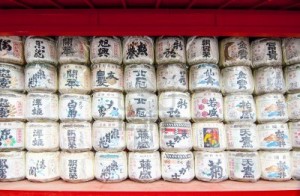
Sake is an alcoholic beverage that is made from fermented rice.
The origin of sake is found before 8th century. It is considered that it has been introduced from Southern China, but then the Japanese government of those days had the special department of Sake masters to refine the quality and develop their own brewing techniques.
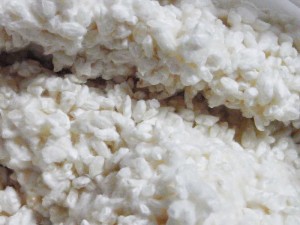
Sake is made from rice, water, and Koji mold. The rice has a starch component in the center of the grains. Koji mold produces various enzymes which trigger the conversion from starch to sugar and from sugar to alcohol simultaneously.
Because of this unique brewing process, it contains as high as 18% – 20% alcohol, higher than other fermentation liquor like wine and beer.
Sake has been the center of Japanese cuisine in all ages.
Soy Sauce

Soy sauce is a liquid condiment produced from a fermented paste of boiled soybeans, roasted grain, and brine. It is brewed in a complex fermentation process with Koji mold, yeasts, and other microorganisms, resulting in containing much amino acids and other Umami components.
The origin is found in China in the 2nd century BC and spread throughout Asia and soy sauce became a traditional ingredient in each countries. There is an evidence that people in Japan in BC had preserved soybeans with salt, and this developed to soy sauce and miso later. The central government in the 8th century had a special department of Hishio masters (Hishio includes soy sauce and Miso) just like Sake master department. The present model of soy sauce was established in the 13th century, but it had not been so common to the public for centuries because it took 3 years to produce soy sauce and there wasn’t enough supply.
It was after 17th century that the more productive brewing process was invented and it spread out the nation. It was the time that now the traditional Japanese cuisine was invented. Sushi, Tempura, Soba noodle, they are all based on the taste of soy sauce. The spread of soy sauce in the nation made it happen.
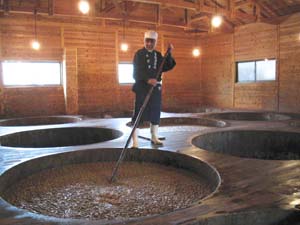
It’s hard to make recommendation as it’s hard to get good Japanese soy sauce outside Japan. You probably see a Kikkoman, but personally I don’t like it very much. Kikkoman is the biggest soy sauce maker in Japan and a lot of Japanese families use it at home. My mother used it as a matter of fact. But Kikkoman is chemically compounded. If you compare tasting Kikkoman and the real brewed soy sauce, it wouldn’t take an expert to tell the difference. Kikkoman is really sharp salty, while the real soy sauce is not only so rich in flavor and aroma but also so mild to the taste.
But if I don’t see other Japanese soy sauce, I would use Kikkoman rather than other country’s soy sauce.
Chinese soy sauce is probably the most popular soy sauce you see outside of Japan. Each Asian countries have different use and different flavor of soy sauce, and I would not use it simply because I just don’t know. Some are very sweet. Some are salty really sharp. No good or bad. They just have different backgrounds. If you want to stick with the golden ratio and make Japanese seasoning, choose a Japanese soy sauce.
If you ever have a chance like visiting Japan or asking your friend to bring you a souvenir from Japan, please try to ask for a real brewed “本醸造” soy sauce or one that’s certified grade A “特級” by JAS, and confirm no Kikkoman.
Mirin
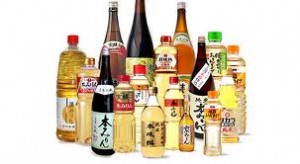
Mirin is sweet Sake for cooking ingredient which contains 14% alcohol and 40 to 50% sugar. It’s brewed like Sake for about 3 months with sticky rice, water, Koji mold, and liquor. Because liquor is already present at the fermentation process, the starch converts to sugar but the next conversion from sugar to alcohol is suppressed by the already present liquor and sugar stays in as the sweetness of this Sake. So this sugar is not from sugarcane, but from the rice grain.
The origin is unknown but it seems to appear on the history as drinking Sake in the 15th century. Then in the 17th century when the traditional Japanese cuisine like Sushi and Tempura is being formed, Mirin was taken into the chefs recipe for its various properties.
- Mirin gives sweetness to the end flavor. It tastes richer but leaves lighter aftertaste than sugarcane sugar.
- Mirin contains amino acids and succinic acid to give Umami.
- Mirin gives savory aroma when heated.
- Mirin puts on glaze on the material. Teri as in Teriyaki means glaze. Mirin is essential to Teriyaki sauce.
- Succinic acid of Mirin cancels out the odor of fish.
- Mirin gives firmness to the material and it prevents a fragile material like fish meat from collapsing.
- Alcohol of Mirin infiltrates the seasonings to the material.
So it’s not so good to cook a chunk of meat with Mirin as it makes the meat firm.
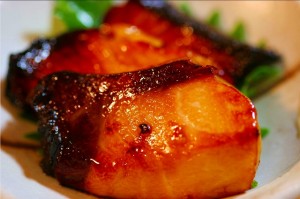
There is a product Mirin-like seasoning. It is confusing. But it’s cheap. It’s a product to get away from the tax that Japanese government puts on liquors. Some have less than 1% alcohol. Some have 10% alcohol but also certain % of salt so that it’s considered seasoning, not liquor.
Whatever it is, Mirin-like seasoning has different properties than real brewed Mirin. Get real Mirin.
Mirin is actually harder to get outside Japan than Sake and soy sauce. I’ve seen Mirin-like seasoning in a Asian food store in US, but not the real Mirin. The Mirin-like seasoning is probably easier to import/export. If it says “Hon Mirin”, that’s real brewed one. So if you ever have a chance to get a help from a Japanese person, use it.
Dashi
Dashi means broth, soup stock. The most basic and common Dashi is Katsuo Dashi, Skipjack Tuna broth. This is the heart of Japanese cooking. If you can make good Dashi, your cooking cannot go wrong.
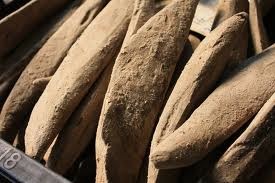
This is not a wood. This is the fish meat. It is called Katsuo Bushi. The fillet of Skipjack Tuna, boiled, dried, smoked, fermented by molds, turning into this hard stick.
It started to be produced in the present from in 15th century.
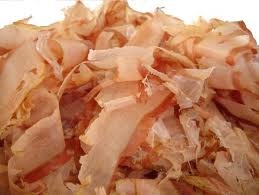
It is used after shaved like this.
The other key ingredient for this broth is Kombu, dried kelp. Glutamic acid from Kombu and inosinic acid from Katsuo Bushi is the best combination of Umami components.
To make Dashi, get a pot of cold water, 3% Scraped Katsuo Bushi and 2% dried Kombu. If you have 1 liter of water, 30g of Katsuo Bushi and 20g of dried Kombu
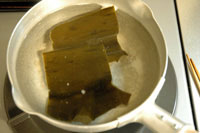
Put Kombu in cold water. Put it on medium heat. The ideal heat is to bring it to boiling in 10 minutes. The gradual heat extracts Umami from Kombu. Don’t keep boiling with Kombu in it as it will make it sticky. Take out Kombu.

Put in a little cold water to decrease the temperature before putting in Katsuo Bushi. Bring it to boil Katsuo Bushi for 1 minute to 5 minutes. Keep it just about boiling as you see some bubbles from the bottom of your pot. Never boil hard. You can add some Sake in it for flavor too. 1 or 2 minutes if you are making soup. 5 minutes if you are using Dashi for cooking meat or vegetables.
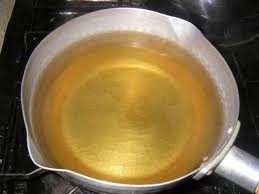
After boiling Katsuo Bushi for the time you like, put out the heat and drain it.
Beautiful golden Dashi.
Boil Off Sake
Now let’s start on how to make the seasoning.

Sake and Mirin contain alcohol. We want to “boil off”. Boil to blow off alcohol.
Put in all the ingredients in a pot and bring it to boil. Keep boiling with medium heat.
Check to smell if there’s alcohol left.
You can also check by lighting a long lighter over the pot (Please be careful). If there’s alcohol left, it sets flames. Let it burn itself out. When the flames are out, you have “boiled off.”
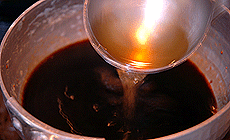
Sake Happou is a light sauce.
You can control the flavor by adding more water to thinner or by boiling more to thicker. As long as the golden ratio of Soy Sauce 1 : Mirin 1 : Sake 4 is there, you can’t go wrong.
A lot of times, we put in sugar to add some sweetness to this. If you are not sure how much sugar to add, replace 1/2 Mirin with the same amount of sugar and see how you like it.
Now that you have Sake Happou, put in fish, Tofu, and vegetables to cook something like the top picture.
You can make this seasoning without putting in water and save. Soy Sauce 1 : Mirin 1 : Sake 4. and boil off in a pot. This is your Teri sauce. When cook, add some water to your liking.
Related Posts
8 Comments
Leave a Reply Cancel reply
Categories
- 1. SPJ (57)
- 1-1. Principles (9)
- 1-2. Techniques (11)
- 1-3. Setup (17)
- 1-4. FAQ (19)
- 1-5. Tackles (3)
- 1-6. Video Gallery (2)
- 2. Other Offshore Games (5)
- 3. Fishing Report (105)
- 3-1. Totos (25)
- 3-2. Readers (72)
- 4. Fish Cooking (19)
- 4-1. Iki-Jime (3)
- 4-2. The Art of Sashimi (5)
- 4-3. Recipe (7)
- 4-4. Seasoning (3)
- 5. Fishing Charter (6)
- Fish (12)

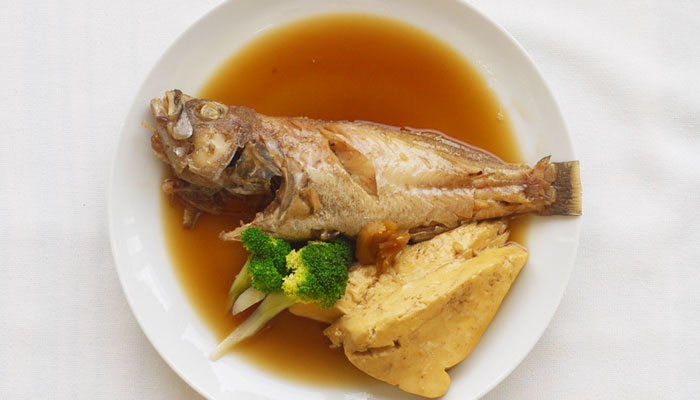

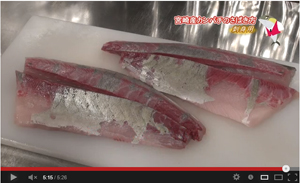

Beautiful! bet its awesome with grouper
Hi Daniel.
Yes, it’s really good with fish with lots of oil. Fish like Grouper, Kingfish, Yellowtail, Mackerel.
Fantastic
Can’t wait to try this.
Thank you Totos.
Hi Daz,
I will try to write up posts about Japanese cooking recipes more often. Thank you for pushing me toward it.
Hi Totos,
Thank you for going into fine details of each ingredient, I always love to cook Sake Happou with fish especially the heads of Kampachi. I am wondering that the zaru soba source is also the variation of Sake Happou, correct?
Thank again.
Hi Kitidas.
Hmmm. You are talking about “Nitsuke” with amberjack head. Yes, this sauce is probably the best to cook fish head.
I added some description on the usage of sugar to the post. Check out the last paragraph.
Yes, the dipping soup for soba noodle is a variation of this.
In reality, we call the soy sauce and mirin component “Kaeshi”. Every Japanese chefs have secret ratio of Kaeshi and it often includes sugar and Sake in it too. This is the most important element to determine the taste.
For dipping sauce, Kaeshi 1 : Dashi 3 to 4.
For noodle soup, Kaeshi 1 : Dashi 7 to 10.
Ok here goes.
about to attempt “sake happou”
Will return with results.
Hi Totos!
whats the sauce they use with onsen tamago?
my favourite!